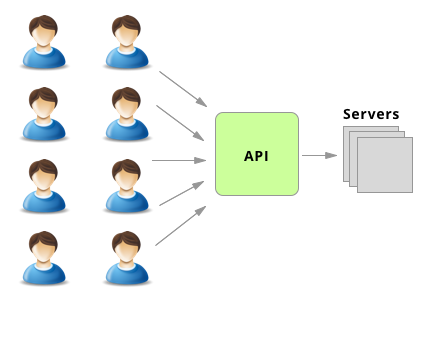CMSC389L
Week 10
APIs
Friday, November 3, 2017
APIs

APIs: Overview
- An application programming interface (API) is a set of clearly defined methods of communication between various software components.
- Can build apps as interconnected modules.
- Expose resources as building blocks for more complex applications
- Hidden implementation details

APIs: SaaS Businesses
- APIs are fundamental to how many SaaS companies work
- The API is their business model




APIs: Other Examples
- You've built APIs before:
- Java classes
- public methods vs. private implementation details
- Java classes
- You've used them before:
- java.util
- Websites
- Many varieties of APIs:
- Databases
- GUIs!
- etc.

APIs: HTTP Protocol
- Web-based APIs commonly communicate via HTTP
- HTTP: HyperText Transfer Protocol
- Stateless, application-layer data transmission protocol
- Foundation of data communication on the modern web
- Important HTTP components:
- URLs
- Verbs
- Status Codes
- Headers

HTTP: Urls

From umd.io:
http://api.umd.io/v0/courses?dept_id=CMSC,BMGT&credits<2
HTTP: Verbs
- URLs specify what resource to interact with
- Verbs specify how to interact with the resource
- Verbs:
-
GET: fetch an existing resources
- special: browsers expect idempotency!
- POST: create a new resource.
- PUT: update an existing resource
- DELETE: delete an existing resource
- Others: HEAD, TRACE, OPTIONS, PATCH, ...
-
GET: fetch an existing resources
HTTP: Verb Examples
-
GET
http://api.umd.io/v0/courses?dept_id=CMSC,BMGT&credits<2


HTTP: Verb Examples
$ curl -XPOST https://api.twilio.com/2010-04-01/Accounts/ACXXXXXXXXXXXXXXXXXXXXXXXXXXXXXXXX/Messages.json \
-d "Body=Jenny%20please%3F%21%20I%20love%20you%20<3" \
-d "To=%2B15558675309" \
-d "From=%2B14158141829" \
-d "MediaUrl=http://www.example.com/hearts.png" \
-u 'ACXXXXXXXXXXXXXXXXXXXXXXXXXXXXXXXX:your_auth_token'


HTTP: Status Codes
- Status codes instruct the client on how to interpret a response.
- 3 digit number (100 - 599)
- A canonical message is associated with each number.
- Status code numbers are split into categories
- 100 - 199: Informational
- 200 - 299: Successful (200: "OK")
- 300 - 399: Redirect
- 301: "Moved", 304: "Not Modified"
-
400 - 499: Client error
- 400: "Bad Request", 401: "Unauthorized"
403: "Forbidden", 429: "Too Many Requests", etc.
- 400: "Bad Request", 401: "Unauthorized"
- 500 - 599: Server error (500: "Internal Error")


HTTP: Headers
- Headers specify metadata in request and response messages.
- Examples of common headers:
- Cookie: $Cart=[4357,3840]; User=1234;
- Authorization: Basic QWxhZGRpbjpvcGVuIHNlc2FtZQ==
- Content-Type: application/json
- Content-Encoding: gzip
- Content-Length: 348
- Expires: Thu, 01 Dec 1994 16:00:00 GMT
APIs: REST
- Many different architectural styles for creating APIs: SOAP, RPC, REST, etc.
-
REpresentational State Transfer (REST):
- series of constraints that improve scalability of the web
-
Resources are expressed with URL ids
- tickets -> GET /tickets
- ticket price -> GET /tickets/:id/price
- etc.
- Requires statelessness, caching, separation of concerns, invisible intermediaries (f.e. load balancers), ...
APIs: Pragmatic API Design
- Pragmatic API design:
- Easy to use APIs -- they should be guessable
- Some basics:
- Resources are nouns (/tickets, /courses, /courses/12, ...)
- Consistent naming scheme, always plural nouns,
- Use versioning, and aim for backwards-compatibility
- Apply filters with query parameters
- Use common generic parameter names
- /tickets?sort=-priority
- Incorporate an API review process
- Pretty print by default
- Avoid abbreviations
- Choose reasonable defaults, minimize boilerplate
APIs: JSON vs. XML

APIs: Pragmatic API Design
- Example: Stripe
- Traditional v1/v2/v3-style versioning
- Upgrading between major versions is hard for developers
- Supporting old versions slows development
- Stripe uses daily versioning
- API upgrades are expressed as transformations
- Benefits:
- Developers can upgrade any time
- Deprecations are rare, rather than regular
- Streamlined API development process
- Traditional v1/v2/v3-style versioning
- Read more: stripe.com/blog/api-versioning
APIs Worksheet
API Demo
API Gateway: What is it?
- Managed infrastructure used to build out web-based REST APIs.
- You'd want an API server to be highly available, secure, and scalable.
- without the time-consuming implementation
- Instead, focus on the business logic (the API itself)

API Gateway: What is it?
- API Gateway allows you to configure your API and redirect requests within your AWS infrastructure.

API Gateway: Benefits
- Benefits:
- Built-in Throttling (429 Error Codes)
- Managed Cache to store API responses
- Security
- Versioning and A/B Testing
- Automatic CloudFront integration (DDoS protection, reduced latency, etc.)
- SDK Generation (mobile, JS, server, etc.)
- API Mocking
- Stages (Dev, Staging, Prod, etc.)
- Automatic Timeouts
- Data Transformations
- Integrated Usage Plans (Sell your API!)
- Centralized logging and metrics
- ...
API Gateway: AWS Support
- Use it with:
- Lambda
- EC2
- DynamoDB
- S3
- Elastic Beanstalk
- ...
- Any web URL, including other APIs
- Proxy APIs
API Gateway: Services


API Gateway Pricing
Three factors in the cost of using API Gateway:
- # of API calls: $3.50 / 1M API calls
- Data Transfer Out: $0.09 / GB
- Optional Caching
Free Tier: 1M API calls / month

API Gateway Demo
Week 10 Feedback

Closing Notes
- Turn in today's worksheet.
- Proposals due this Sunday on Piazza
CMSC389L Week 10
By Colin King
CMSC389L Week 10
- 623



